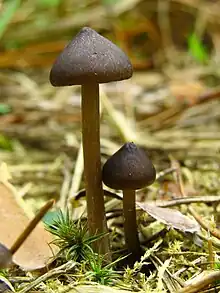Nolanea
Nolanea is a genus of fungi in the order Agaricales, frequently treated as a subgenus of Entoloma. Called pinkgills in English, basidiocarps (fruit bodies) are agaricoid, mostly (but not always) mycenoid (like species of Mycena) with slender stems.[1] All have salmon-pink basidiospores which colour the gills at maturity and are angular (polyhedral) under a microscope. Recent DNA evidence has shown that at least 87 species belong in Nolanea which has a worldwide distribution.[1]
| Nolanea | |
|---|---|
 | |
| Nolanea verna, Ukraine | |
| Scientific classification | |
| Domain: | Eukaryota |
| Kingdom: | Fungi |
| Division: | Basidiomycota |
| Class: | Agaricomycetes |
| Order: | Agaricales |
| Family: | Entolomataceae |
| Genus: | Nolanea (Fr.) P.Kumm. (1871) |
| Type species | |
| Nolanea pascua (Pers.) P.Kumm. (1871) | |
| Synonyms | |
|
Agaricus trib. Nolanea Fr. (1821) | |
Taxonomy
Nolanea was introduced in 1821 by the Swedish mycologist Elias Magnus Fries as a "tribe" of Agaricus comprising slender agarics with bell-shaped caps, hollow stems, and pink spores.[2] In 1871 German mycologist Paul Kummer raised the tribe to genus level.[3] The name has been used by many subsequent mycologists,[4][5][6] but others have preferred to use the name Entoloma sensu lato for all fungi with pink, angular spores, retaining Nolanea as a subgenus.[7]
Recent molecular research, based on cladistic analysis of DNA sequences, has shown that Nolanea, as previously defined, is paraphyletic (an artificial grouping).[8] By excluding some species and adding others, however, Nolanea has been redefined as a monophyletic (natural) grouping.[9][1] In this new sense, Nolanea has been treated either as a subgenus[1] or as a separate genus.[9]
The redefined Nolanea excludes Entoloma rhombisporum and related species, Entoloma ameides and related species, and cuboid-spored species now placed in Entoloma subgenus Cubospora.[1]
References
- Reschke K, Morozova OV, Dima B, Cooper JA, Corriol G, Biketova AY, Piepenbring M, Noordeloos ME (2022). "Phylogeny, taxonomy, and character evolution in Entoloma subgenus Nolanea" (PDF). Persoonia. 49: 136–170. doi:10.3767/persoonia.2022.49.04.
- Fries EM. (1821). Systema Mycologicum (in Latin). Vol. 1. Lundin, Sweden: Ex Officina Berlingiana. pp. 10, 207.
- Kummer, Paul (1871). Der Führer in die Pilzkunde : Anleitung zum methodischen, leichten und sichern Bestimmen der in Deutschland vorkommenden Pilze : mit Ausnahme der Schimmel- und allzu winzigen Schleim- und Kern-Pilzchen. Zerbst: Verlag von E. Luppe's Buchhandlung. pp. 94–97.
- Orton PD (1991). "A revised list of British species of Entoloma sensu lato". The Mycologist. 5 (3): 123–138. doi:10.1016/S0269-915X(09)80307-8.
- Orton PD (1991). "A revised list of British species of Entoloma sensu lato (part 2)". The Mycologist. 5 (4): 172–176. doi:10.1016/S0269-915X(09)80478-3.
- Largent DL (1994). Entolomatoid fungi of the Western United States and Alaska. Berkeley, USA: Mad River Press. ISBN 978-0916422813.
- Noordeloos ME (1992). Fungi Europaei:Entoloma sensu lato. Saronno, Italy: Giovanna Biella. p. 760.
- Co-David D, Langeveld D, Noordeloos ME (2009). "Molecular phylogeny and spore evolution of Entolomataceae" (PDF). Persoonia. 23: 147–76. doi:10.3767/003158509X480944. PMC 2802732. PMID 20198166.
- Karstedt F, Bergemann SE, Capelari M (2020). "Five Nolanea spp. nov. from Brazil" (PDF). Mycotaxon. 135 (3): 589–612. doi:10.5248/135.589.